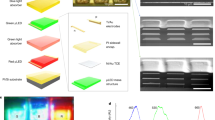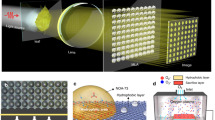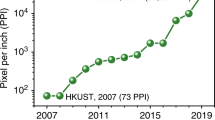Abstract
MicroLED displays have been in the spotlight as the next-generation displays owing to their various advantages, including long lifetime and high brightness compared with organic light-emitting diode (OLED) displays. As a result, microLED technology1,2 is being commercialized for large-screen displays such as digital signage and active R&D programmes are being carried out for other applications, such as augmented reality3, flexible displays4 and biological imaging5. However, substantial obstacles in transfer technology, namely, high throughput, high yield and production scalability up to Generation 10+ (2,940 × 3,370 mm2) glass sizes, need to be overcome so that microLEDs can enter mainstream product markets and compete with liquid-crystal displays and OLED displays. Here we present a new transfer method based on fluidic self-assembly (FSA) technology, named magnetic-force-assisted dielectrophoretic self-assembly technology (MDSAT), which combines magnetic and dielectrophoresis (DEP) forces to achieve a simultaneous red, green and blue (RGB) LED transfer yield of 99.99% within 15 min. By embedding nickel, a ferromagnetic material, in the microLEDs, their movements were controlled by using magnets, and by applying localized DEP force centred around the receptor holes, these microLEDs were effectively captured and assembled in the receptor site. Furthermore, concurrent assembly of RGB LEDs were demonstrated through shape matching between microLEDs and receptors. Finally, a light-emitting panel was fabricated, showing damage-free transfer characteristics and uniform RGB electroluminescence emission, demonstrating our MDSAT method to be an excellent transfer technology candidate for high-volume production of mainstream commercial products.
This is a preview of subscription content, access via your institution
Access options
Access Nature and 54 other Nature Portfolio journals
Get Nature+, our best-value online-access subscription
$29.99 / 30 days
cancel any time
Subscribe to this journal
Receive 51 print issues and online access
$199.00 per year
only $3.90 per issue
Buy this article
- Purchase on Springer Link
- Instant access to full article PDF
Prices may be subject to local taxes which are calculated during checkout




Similar content being viewed by others
Data availability
The data that support the plots in this study are available in figshare with the identifier https://doi.org/10.6084/m9.figshare.21992711.
Code availability
No custom code or mathematical algorithm was used in this study.
References
Anwar, A. R. et al. Recent progress in micro-LED-based display technologies. Laser Photonics Rev. 16, 2100427 (2022).
Huang, Y., Hsiang, E., Deng, M. & Wu, S. Mini-LED, micro-LED and OLED displays: present status and future perspectives. Light Sci. Appl. 9, 105 (2020).
Chen, C., Chen, H., Liao, J., Yu, C. & Wu, M. Fabrication and characterization of active-matrix 960 × 540 blue GaN-based micro-LED display. IEEE J. Quantum Electron. 55, 1–6 (2019).
Kim, R. et al. Stretchable, transparent graphene interconnects for arrays of microscale inorganic light emitting diodes on rubber substrates. Nano Lett. 11, 3881–3886 (2011).
Xu, H., Zhang, J., Davitt, K. M., Song, Y. & Nurmikko, A. V. Application of blue–green and ultraviolet micro-LEDs to biological imaging and detection. J. Phys. D Appl. Phys. 41, 094013 (2008).
Gong, Z. Layer-scale and chip-scale transfer techniques for functional devices and systems: a review. Nanomaterials. 11, 842 (2021).
Meitl, M. A. et al. Transfer printing by kinetic control of adhesion to an elastomeric stamp. Nat. Mater. 5, 33–38 (2006).
Meitl, M. et al. Passive matrix displays with transfer-printed microscale inorganic LEDs. SID Symp. Dig. Tech. Pap. 47, 743–746 (2016).
Kim, J., Kim, B., Lim, D. & Shin, B. Control of adhesion force for micro LED transfer using a magnetorheological elastomer. J. Mech. Sci. Technol. 33, 5321–5325 (2019).
Li, J., Yan, G., Luo, B. & Liu, Z. Study of transfer-printing technologies for micro-LED displays. SID Symp. Dig. Tech. Pap. 51, 125–128 (2020).
Yeh, H. J. & Smith, J. S. Fluidic self-assembly for the integration of GaAs light-emitting diodes on Si substrates. IEEE Photon. Technol. Lett. 6, 706–708 (1994).
Talghader, J. J., Tu, J. K. & Smith, J. S. Integration of fluidically self-assembled optoelectronic devices using a silicon-based process. IEEE Photon. Technol. Lett. 7, 1321–1323 (1995).
Jacobs, H. O., Tao, A. R., Schwartz, A., Gracias, D. H. & Whitesides, G. M. Fabrication of a cylindrical display by patterned assembly. Science 296, 323–325 (2002).
Stauth, S. A. & Parviz, B. A. Self-assembled single-crystal silicon circuits on plastic. Proc. Natl Acad. Sci. 103, 13922–13927 (2006).
Fang, J. & Bohringer, K. F. Parallel micro component-to-substrate assembly with controlled poses and high surface coverage. J. Micromech. Microeng. 16, 721–730 (2006).
Cho, S., Lee, D. & Kwon, S. in Proc. 2019 20th International Conference on Solid-State Sensors, Actuators and Microsystems & Eurosensors XXXIII (TRANSDUCERS & EUROSENSORS XXXIII) 402–404 (IEEE, 2019).
Park, S. et al. A first implementation of an automated reel-to-reel fluidic self-assembly machine. Adv. Mater. 26, 5942–5949 (2014).
Knuesel, R. J. & Jacobs, H. O. Self-assembly of microscopic chiplets at a liquid–liquid–solid interface forming a flexible segmented monocrystalline solar cell. Proc. Natl Acad. Sci. 107, 993–998 (2010).
Park, S. et al. Approaching roll-to-roll fluidic self-assembly: relevant parameters, machine design, and applications. J. Microelectromech. Syst. 24, 1928–1937 (2015).
Mertens, R. eLux installs a new automated fluidic assembly R&D tool, unveils a new microLED display prototype. MICROLEC-info https://www.microled-info.com/elux-installs-new-automated-fluidic-assembly-rd-tool-unveils-new-microled (2021).
Virey, E. H. & Baron, N. Status and prospects of microLED displays. SID Symp. Dig. Tech. Pap. 49, 593–596 (2018).
Park, H. et al. Horizontally assembled green InGaN nanorod LEDs: scalable polarized surface emitting LEDs using electric-field assisted assembly. Sci. Rep. 6, 28312 (2016).
Park, K. S., Hoo, J. H., Baskaran, R. & Bohringer, K. F. Parallel heterogeneous integration of chip-scale parts by self-assembly. J. Microelectromech. Syst. 21, 1273–1275 (2012).
Wang, X., Wang, X. & Gascoyne, P. R. C. General expressions for dielectrophoretic force and electrorotational torque derived using the Maxwell stress tensor method. J. Electrostat. 39, 277–295 (1997).
Gangwal, S., Cayre, O. J. & Velev, O. D. Dielectrophoretic assembly of metallodielectric Janus particles in AC electric fields. Langmuir 24, 13312–13320 (2008).
Cetin, B. & Li, D. Dielectrophoresis in microfluidics technology. Electrophoresis 32, 2410–2427 (2011).
Honegger, T., Lecarme, O., Berton, K. & Peyrade, D. 4-D dielectrophoretic handling of Janus particles in a microfluidic chip. Microelectron. Eng. 87, 756–759 (2010).
Mayer, T. S., Jackson, T. N. & Nordquist, C. D. Electro-fluidic assembly process for integration of electronic devices onto a substrate. US patent US6687987B2 (2004).
Freer, E. M., Grachev, O., Duan, X., Martin, S. & Stumbo, D. P. High-yield self-limiting single-nanowire assembly with dielectrophoresis. Nat. Nanotechnol. 5, 525–530 (2010).
Pesch, G. R. & Du, F. A review of dielectrophoretic separation and classification of non-biological particles. Electrophoresis 42, 134–152 (2021).
Ginoudi, A. et al. in Proc. Fourth International Conference on Indium Phosphide and Related Materials 389–392 (IEEE, 1992).
Acknowledgements
We would like to thank all the engineers of the Materials & Devices Advanced Research Center involved in this work for their contribution.
Author information
Authors and Affiliations
Contributions
W.C. conceived and designed most of the simulations and the experiments. W.C. also wrote the manuscript. J.K. supervised the self-assembly processes and all simulations. M.K. designed and conducted all simulations. M.K. analysed the high-speed video images and fabricated the RGB microLED panel. M.W.L. contributed the theoretical aspects of this work. G.K. performed and analysed all the self-assembly processes. G.K. also measured the electroluminescence and the I–V characteristics of the RGB microLED panel. M.K., C.H.L. and S.H. fabricated the RGB microLEDs. J.C. fabricated the assembly substrates and carried out the literature review. Y.H.M. analysed data related to the fabrications and the self-assembled structures of the microLEDs. K.J. supervised the overall results of this work. J.K. and S.K. supervised the fabrication and the characterization of the RGB microLED panel. Y.-H.C. provided notable revisions of the manuscript. Y.-H.C. and J.S.L. supervised the project and advised on the overall results in the manuscript. All authors discussed the results.
Corresponding authors
Ethics declarations
Competing interests
The authors declare no competing interests.
Peer review
Peer review information
Nature thanks In-Hwan Lee and the other, anonymous, reviewer(s) for their contribution to the peer review of this work.
Additional information
Publisher’s note Springer Nature remains neutral with regard to jurisdictional claims in published maps and institutional affiliations.
Extended data figures and tables
Extended Data Fig. 1 Schematic cross-sectional view of microLEDs.
a, Schematic of the GaN-based microLED. A ferromagnetic material (nickel) is embedded in a half-moon shape of n-contact metals (Cr/Ti/Ni/Ti). The sidewalls and top are surrounded by a 500-nm-thick SiO2 layer. A titanium metal layer is included on the bottom. The thin layers of multiquantum wells are not shown because they were not applied in the COMSOL simulations. b, Schematic of the AlGaInP-based microLED. A ferromagnetic material (nickel) is embedded in the ring-shaped n-contact metals (AuGe/Au/Ti/Ni/Ti). The separation between the Ni layer and the edge of the microLED is indicated by the dashed lines; this separation prevents the microLEDs from adhering together owing to magnetization after magnetic manipulation (figure not drawn to scale).
Extended Data Fig. 2 Transfer yield under the optimal voltage (12 Vpp).
Transfer yield from 15 repeated experiments on a 75 mm × 75 mm assembly substrate. The average of the 15 transfer yield values is 99.99%.
Extended Data Fig. 3 Transfer yield of FSA with element size.
The data from previous studies are categorized into capillary force (open circles) and surface tension (open triangles). The respective reference numbers are provided in square brackets. The yield in this work is marked with a closed circle.
Extended Data Fig. 4 Microscope image of RGB microLEDs and the DEP force from COMSOL simulations.
Microscope image of AlGaInP-based red LED with a microLED size of 38 μm diameter (a), GaN-based green LED with a microLED size of 45 μm × 31 μm (b) and GaN-based blue LED with a microLED size of 52 μm × 24 μm (c). All scale bars denote 20 μm. d, Change in the DEP force with frequency at a fixed value (12 Vpp) of the applied voltage. e, Change in the DEP force with frequency at a fixed value (12 Vpp) of the applied voltage with modified RGB microLEDs that have a metal layer (titanium) on the bottom surface.
Extended Data Fig. 5 Schematic diagram of a 3D model for COMSOL simulations and variation of the DEP force with three factors.
a, Schematic diagram illustrating three factors (gap ratio, LED chip size and dielectric layer) that influence the DEP force. The gap ratio is defined as the ratio of the distance between the two assembly electrodes to the diameter of the LED. Change in the DEP force as a function of gap ratio, LED chip size and a dielectric layer of SiO2 (b) or Si3N4 (c), respectively.
Supplementary information
Supplementary Video 1
MDSAT method. Video of MDSAT assembled with 12 Vpp and 100 kHz of an applied voltage.
Rights and permissions
Springer Nature or its licensor (e.g. a society or other partner) holds exclusive rights to this article under a publishing agreement with the author(s) or other rightsholder(s); author self-archiving of the accepted manuscript version of this article is solely governed by the terms of such publishing agreement and applicable law.
About this article
Cite this article
Chang, W., Kim, J., Kim, M. et al. Concurrent self-assembly of RGB microLEDs for next-generation displays. Nature 617, 287–291 (2023). https://doi.org/10.1038/s41586-023-05889-w
Received:
Accepted:
Published:
Issue Date:
DOI: https://doi.org/10.1038/s41586-023-05889-w
This article is cited by
-
Self-assembled photonic cavities with atomic-scale confinement
Nature (2023)
-
Universal selective transfer printing via micro-vacuum force
Nature Communications (2023)
Comments
By submitting a comment you agree to abide by our Terms and Community Guidelines. If you find something abusive or that does not comply with our terms or guidelines please flag it as inappropriate.



